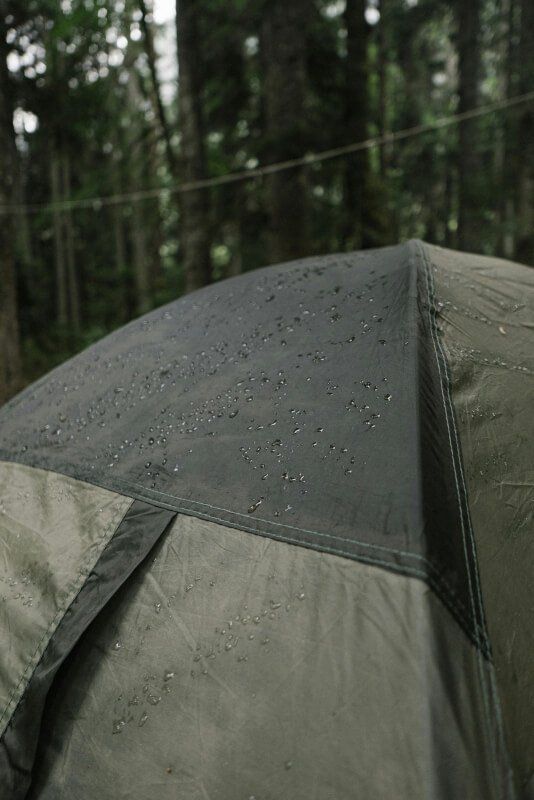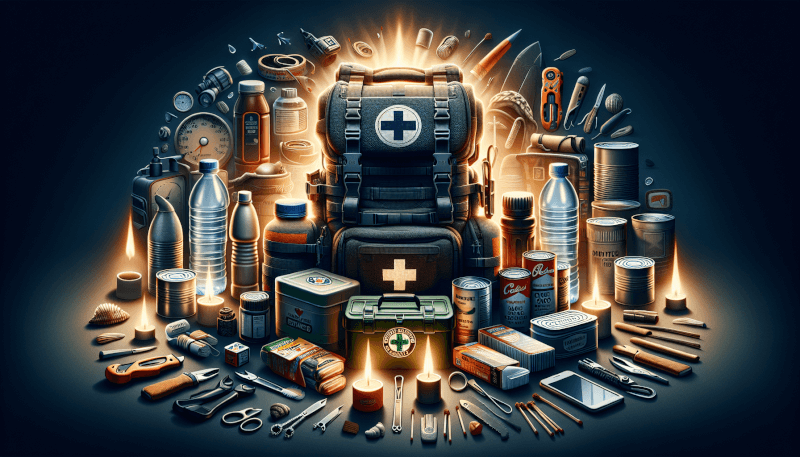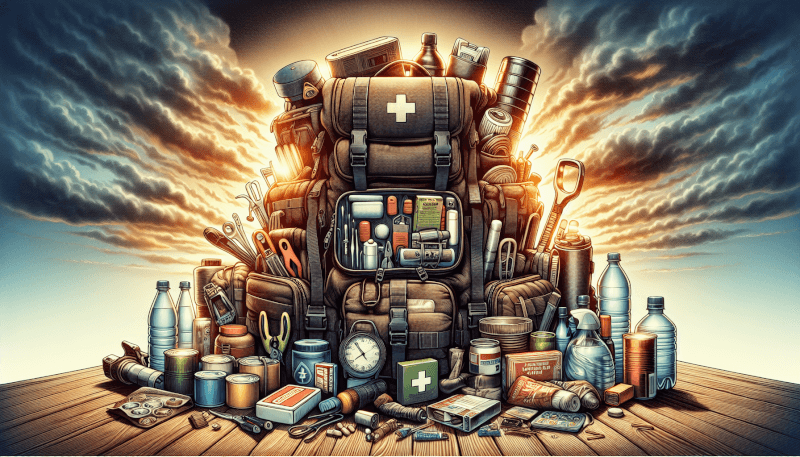Imagine a world where chaos reigns and disaster strikes without warning. It’s a scary thought, but it’s important to be prepared for the worst-case scenario. In “When All Hell Breaks Loose: Stuff You Need To Survive When Disaster Strikes,” you will uncover invaluable information on the essential items you need to have on hand during times of crisis. From food and water to communication tools and first aid supplies, this article will guide you through the must-haves that can mean the difference between survival and struggle. So, get ready to equip yourself with the knowledge to thrive in the face of adversity.

Water
Water is one of the most crucial resources for survival, and ensuring you have enough water is of utmost importance during a disaster situation. Whether it’s a natural disaster or a sudden emergency, having access to clean and safe water should be at the top of your priority list. Here, we will discuss water storage, water filtration, and water purification methods to help you be prepared.
Water Storage
Having a sufficient supply of stored water is vital during a crisis. The general rule of thumb is to have at least one gallon of water per person per day for both drinking and sanitation purposes. It’s recommended to store enough water to last for a minimum of three days and ideally up to two weeks.
Various options are available for water storage, including large water containers, barrels, or even portable water pouches. Consider the storage capacity you require based on the size of your household and the number of individuals you need to cater to during an emergency. Ensure that the water containers you choose are durable, air-tight, and stored in a cool, dark place away from direct sunlight.
Water Filtration
In a disaster scenario, it’s crucial to have a backup plan for obtaining safe drinking water in case your stored supply runs out. Water filtration methods can help eliminate contaminants and make water from potentially unsafe sources, such as rivers or lakes, drinkable.
There are different types of water filters available, including portable filters, pump filters, and gravity filters. These filters work by physically removing impurities, bacteria, and parasites from the water, providing you with clean and safe drinking water. It’s important to choose a filtration system that suits your needs and is capable of removing a wide range of contaminants.
Water Purification
Water purification involves not only filtering out impurities but also killing or neutralizing harmful microorganisms that may be present in the water. When it comes to water purification, there are various methods you can employ to ensure the water you consume is free of germs and safe for drinking.
One commonly used method is boiling water. Boiling water for at least one minute can effectively kill most types of disease-causing organisms. Chemical water purifiers, such as chlorine or iodine tablets, can also be used to treat water by destroying pathogens. However, it’s important to follow the manufacturer’s instructions carefully to ensure proper dosage and treatment.
Another option for water purification is using UV light sterilizers. These handheld devices emit ultraviolet light that is capable of killing bacteria, viruses, and other harmful microorganisms present in the water. Keep in mind that these devices usually require batteries or a power source to operate, so it’s crucial to have backup power sources available.
Food
During a disaster, access to food may become limited, making it essential to have a stockpile of non-perishable food items and emergency food supplies. Additionally, having knowledge of various cooking methods that can be used in a crisis is advantageous.
Non-perishable Food
Non-perishable food items are those that have a long shelf life and do not require refrigeration. These items can be stored for an extended period and provide sustenance during times when fresh food is unavailable. Some examples of non-perishable foods include canned fruits and vegetables, dried fruits, nuts, trail mix, granola bars, canned soups, and ready-to-eat meals such as MREs (Meals Ready to Eat).
When stocking up, consider the nutritional value and dietary restrictions of the individuals in your household. Ensure that you have a variety of non-perishable foods that can meet everyone’s dietary needs. Don’t forget to regularly check the expiration dates of these items and rotate them to maintain freshness.
Emergency Food Supplies
In addition to non-perishable foods, it’s wise to have emergency food supplies specifically designed for disaster situations. These supplies often come in the form of pre-packaged, long-lasting meals that require minimal preparation.
Emergency food supplies can be purchased from reputable suppliers and typically consist of dehydrated or freeze-dried meals. These meals can be easily rehydrated with water and provide necessary nutrients and energy. Consider the recommended storage conditions and shelf life of these supplies to ensure they remain viable for an extended period.
Cooking Methods
When disaster strikes, conventional cooking methods may not be available, making it important to have alternative ways to prepare food. Having appropriate cooking methods in place will allow you to maintain a balanced diet even when faced with challenging circumstances.
Portable stoves, such as camping stoves or propane stoves, are excellent options for outdoor cooking during emergencies. These stoves use small propane canisters or other fuel sources and provide a reliable means of preparing meals. Additionally, make sure you have an ample supply of fuel on hand to sustain your cooking needs.
For indoor cooking, consider using alternative heat sources such as a butane stove or even a charcoal grill (used outdoors, away from flammable materials). It’s crucial to use these devices in a well-ventilated area and follow all safety precautions to prevent accidental fires or carbon monoxide poisoning.

Shelter
In a disaster situation, having suitable shelter is crucial for your safety and well-being. Whether you need temporary shelter while evacuating or a safe home to ride out the storm, being prepared with the necessary information and supplies is essential.
Emergency Shelter Options
When faced with an imminent threat, evacuation may be necessary, and having knowledge of emergency shelter options can be a lifesaver. Local authorities and emergency management agencies often establish designated shelters in schools, community centers, or other secure locations.
Stay updated through reliable sources such as local news and emergency services to learn about available emergency shelters in your area. Keep a list of these shelters along with their contact information, addresses, and the quickest routes to reach them in case you need to evacuate quickly.
Creating a Safe Home
If evacuation is not necessary or feasible, creating a safe home is paramount to protect yourself and your loved ones during a disaster. There are several steps you can take to fortify your house and make it more resistant to potential hazards.
Start by securing doors and windows with sturdy locks or additional barriers. Reinforce them with storm shutters or coverings if available, or use thick plywood as a temporary measure. This will help protect your home against strong winds, flying debris, and potential intruders.
Inspect your roof for any signs of damage or loose shingles that may lead to leaks or additional vulnerability during severe weather. Repair or reinforce these areas promptly to ensure your home remains watertight and resilient.
Consider reinforcing the foundation of your home, especially if you live in an area prone to earthquakes or other ground movement. Consult with a professional to evaluate the foundation’s stability and explore options for reinforcement.
Ensure you have an emergency kit with supplies such as a flashlight, batteries, a first aid kit, and essential medications. Store important documents and records in a waterproof and easily accessible container.
Building a Temporary Shelter
In some emergency situations, you may need to rely on a temporary shelter to provide immediate protection and a sense of safety. Knowing how to build a simple shelter using readily available materials can be invaluable in times of need.
Tarps or plastic sheets can be used to create a basic shelter by tying them to trees or other existing structures. Ensure the shelter is positioned on higher ground to avoid potential flooding and choose a location away from hazards such as falling trees or rockslides.
If you have access to wood, branches, or other natural materials, consider constructing a lean-to shelter. This type of shelter utilizes a sloping roof made from sturdy branches or poles, providing both a cover from the elements and a comfortable space to rest.
For added insulation and protection, layer leaves, grass, or other natural materials on the roof and sides of the shelter. These additional layers will help regulate temperature and provide a more comfortable environment.
Remember to prioritize safety when building a temporary shelter and seek assistance when needed. Always be mindful of your surroundings and potential risks to ensure your shelter remains a safe haven during emergencies.
First Aid
During a disaster, medical assistance may not be readily available, making basic first aid knowledge and supplies essential. A well-equipped first aid kit, along with additional medical supplies and emergency medicines, can help you address injuries and illnesses that may occur during a crisis.
Basic First Aid Kit
A basic first aid kit should contain essential supplies to address common injuries such as cuts, burns, sprains, and minor wounds. A comprehensive kit may include items such as adhesive bandages, antiseptic wipes, gauze pads, adhesive tape, scissors, tweezers, disposable gloves, and a CPR mask.
It’s important to periodically check and replenish the contents of your first aid kit to ensure that supplies are not expired and remain in usable condition. Additionally, consider including a first aid manual or guidebook to refresh your knowledge on administering basic first aid techniques.
Medical Supplies
In addition to a basic first aid kit, consider having additional medical supplies on hand to manage more severe injuries or medical conditions. This can include items such as splints, sterile dressings, instant cold packs, trauma shears, and a thermometer.
If you or someone in your household requires specific medications or medical equipment, it’s crucial to have an ample supply of these items. Ensure that medications are not expired and are stored properly to maintain their effectiveness.
Consult with your healthcare provider to determine any additional medical supplies you may require based on pre-existing conditions or specific needs. It’s also recommended to have a list of emergency contacts, including phone numbers and addresses of local hospitals or medical facilities.
Emergency Medicine
During a disaster, access to regular medical care may be limited, making it prudent to have essential emergency medicines on hand. These medications can help manage common symptoms or conditions that may arise during a crisis.
Stocking up on over-the-counter pain relievers, antacids, anti-diarrheal medications, and allergy medications can provide much-needed relief during stressful times. If you or someone in your household requires prescription medications, it’s essential to have a sufficient supply to last throughout the crisis.
Ensure that all medications are stored properly, away from heat, humidity, or direct sunlight. Regularly check expiration dates and rotate medications as needed to maintain their effectiveness.

Communication
Maintaining communication during a disaster is vital for receiving updates, seeking assistance, and staying connected with loved ones. Having access to emergency contact information, portable radios, and alternative communication methods can be a lifeline in challenging situations.
Emergency Contact Information
Compile a list of emergency contacts, including phone numbers and addresses of local police or fire departments, hospitals, utility companies, and other essential services in your area. This information should be readily accessible to everyone in your household and stored both digitally and in hard copies.
Consider designating an out-of-town contact person who can serve as a central point of communication for your family or friends. In case local phone lines are disrupted, long-distance calls may be more reliable, and this designated contact person can relay messages between family members.
Portable Radio
A portable radio is a crucial communication device during a disaster, as it allows you to receive updates and crucial information from local authorities or emergency services. Look for a battery-powered or hand-cranked radio that can operate even when power sources are unavailable.
Keep spare batteries or ensure that your radio has a hand-crank for generating power. Also, familiarize yourself with local news or radio stations that provide emergency broadcasts, as they can provide invaluable information during a crisis.
Alternative Communication Methods
In case traditional communication methods such as phone lines or internet access are disrupted, having alternative communication options is essential. Explore various methods to stay connected, such as using walkie-talkies or two-way radios within a limited range to communicate with family members or neighbors.
Additionally, consider having a whistle or other signaling devices that can be used to attract attention or indicate your location during a search and rescue situation. Learning Morse code or other universally understood distress signals can also prove helpful in communicating your needs effectively.
Remember to conserve power and use communication devices sparingly to preserve battery life. Prioritize essential communication needs and avoid unnecessary use to ensure your devices remain operational when needed most.
Lighting
During a disaster or power outage, adequate lighting is crucial for navigating your surroundings safely and maintaining a sense of security. Having reliable light sources such as flashlights, emergency candles, and battery-powered lanterns can greatly enhance your visibility and overall well-being.
Flashlights
A flashlight is an essential tool in any survival kit, providing portable and reliable illumination whenever needed. Invest in high-quality, durable flashlights that are waterproof and equipped with long-lasting LED bulbs. Also, consider having spare batteries readily available to ensure uninterrupted functionality.
Store flashlights in easily accessible locations and strategically place them in areas such as bedrooms, hallways, and near emergency exits. Regularly check and maintain your flashlights, including occasional battery replacements and cleanliness, to ensure they are always ready for use.
Emergency Candles
Emergency candles are an excellent backup lighting source during extended power outages. They provide a softer, more ambient light that can create a sense of comfort and reduce anxiety. Choose long-burning candles made from non-drip wax for added safety.
When using candles, always observe proper fire safety precautions. Ensure that candles are placed on stable surfaces away from flammable materials and never leave candles unattended. Consider investing in candle lanterns to enhance both the safety and efficiency of your lighting setup.
Battery-powered Lantern
Battery-powered lanterns offer a convenient lighting solution for larger areas or when sustained illumination is required. Look for lanterns that use energy-efficient LED bulbs and have multiple brightness settings to conserve battery life.
These lanterns are typically portable, making them easy to carry from room to room or even outside when needed. Additionally, some lanterns come with extra features such as built-in phone chargers or emergency signal lights, further enhancing their utility during a crisis.
Ensure that your battery-powered lanterns are regularly checked for working batteries and stored in a location that is easily accessible to everyone in your household. Familiarize yourself and your family with the operation and maintenance of these devices to maximize their effectiveness.

Energy
In a disaster scenario, access to regular power sources may be disrupted, making it essential to have backup energy options. Consider utilizing backup power sources, solar panels, and learn how to safely operate generators to ensure you have a reliable source of energy during an emergency.
Backup Power Sources
Having backup power sources is crucial for powering essential devices and maintaining communication, especially during extended outages. Portable power banks or rechargeable battery packs provide a convenient means of charging small devices such as smartphones, radios, or flashlights.
Consider investing in rechargeable batteries for frequently used devices, such as flashlights or radios, as they can be recharged using external power sources. Additionally, keep spare batteries for these devices to quickly replace depleted ones.
Solar Panels
Harnessing the power of the sun can provide a sustainable and renewable source of energy during a disaster. Solar panels can generate electricity to charge batteries or power small devices, reducing dependency on traditional power sources.
Invest in portable solar panels specifically designed for charging devices or powering essential equipment. These panels are lightweight, foldable, and easy to transport. Ensure that you have the necessary adapters and cables to connect your devices to the solar panels.
Familiarize yourself with the positioning and setup of solar panels to optimize their exposure to sunlight. Regularly check the condition of your solar panels, ensuring they are free from debris and properly functioning. Shaded or damaged panels will not generate the expected power output.
Generator Safety
When relying on a generator for backup power, it’s essential to follow proper safety procedures to prevent accidents and health hazards. Generators should always be used outside and away from homes, garages, or any enclosed spaces to avoid carbon monoxide poisoning.
Ensure that your generator is properly grounded and connected to the appropriate equipment to safely distribute power. Consult the manufacturer’s instructions and avoid overloading the generator to prevent potential electrical hazards.
Regularly inspect and maintain your generator, including checking oil levels, refueling safely, and keeping it clean from debris. Remember to handle fuel and other flammable substances with caution and store them in approved containers away from ignition sources.
Learn basic generator troubleshooting techniques to address common issues that may arise. Being familiar with your generator’s operation and maintenance will help ensure its reliability and effectiveness when you need it most.
Tools and Equipment
In a disaster situation, having the right tools and equipment can greatly enhance your ability to navigate and overcome challenges. Consider including multi-tools, fire starters, and portable stoves in your preparedness kit to handle various tasks efficiently.
Multi-tool
A multi-tool is a versatile and compact tool that combines several functions into a single device. Having a dependable multi-tool can greatly assist with various repairs and tasks during a crisis. Look for a multi-tool that includes features such as pliers, knives, screwdrivers, saws, and even a can opener.
Consider the specific needs of your household when choosing a multi-tool. For example, if you live in an area prone to hurricanes, having a tool with a built-in window breaker and seatbelt cutter can be invaluable in case of vehicle entrapment.
Fire Starters
In a survival situation, the ability to start a fire is paramount for cooking, warmth, and even signaling for help. Reliable fire starters can help ignite fires quickly, even in adverse conditions such as rain or strong winds.
Consider including a dependable fire starter, such as waterproof matches or a fire starter rod, in your emergency kit. These tools are designed to provide a consistent source of ignition even when traditional methods fail. Additionally, it’s crucial to have fire-safe tinder or kindling readily available to sustain the fire.
Remember to exercise caution when starting a fire, ensuring it is located in a safe area away from flammable materials. Only start fires in designated fire pits or areas where permitted by local regulations.
Portable Stove
A portable stove can provide a reliable means of cooking food and boiling water during a crisis. Look for lightweight, compact stoves that are easy to transport and operate. Consider fuel options such as butane canisters or alcohol burners, ensuring you have an ample supply on hand.
Some portable stoves come with built-in wind shields or stable bases to enhance their effectiveness in outdoor settings. Familiarize yourself with the operation and maintenance of your chosen stove, including safety precautions and proper fuel usage.
Keep your portable stove in a convenient location with easy access to your emergency cooking supplies and food storage. Practice using it before an emergency to become proficient in its operation and ensure you have all the necessary tools and equipment for safe cooking.

Personal Hygiene
Maintaining proper personal hygiene is essential for staying healthy and preventing the spread of diseases, especially during a crisis. Having appropriate sanitation supplies, hygiene kits, and essentials for baby and elderly care can help ensure the well-being of everyone in your household.
Sanitation Supplies
When regular water and plumbing systems are disrupted, ensuring proper sanitation becomes a challenge. However, maintaining good hygiene practices is crucial for preventing the spread of diseases and maintaining overall well-being.
Stock up on sanitation supplies such as toilet paper, wet wipes, hand sanitizers, soap, and disinfecting sprays or wipes. Consider including disposable gloves and garbage bags for safe disposal of waste materials.
In case access to a functioning toilet is limited or unavailable, consider alternative sanitation options such as portable camping toilets or bucket toilets. These options provide a more hygienic alternative to open defecation and allow for easier disposal of waste.
Hygiene Kits
Hygiene kits are a comprehensive collection of personal care items necessary to maintain cleanliness and prevent the spread of disease. They often include items such as toothbrushes, toothpaste, soap, shampoo, deodorant, feminine hygiene products, and towels.
Prepare hygiene kits for each member of your household, considering their individual needs and preferences. Additionally, store any necessary prescription medications, glasses, or contact lens supplies to maintain proper personal care.
Regularly check and replenish the items in your hygiene kits to ensure they remain usable and do not expire. Store these kits in a clean and easily accessible location, keeping them separate from food or potentially hazardous materials.
Baby and Elderly Care Items
Special attention should be given to the needs of infants, toddlers, and the elderly during a disaster. It’s important to include essential baby and elderly care items in your preparedness kit to ensure the comfort and well-being of these vulnerable individuals.
For infants, include items such as baby formula, bottles, diapers, wet wipes, and any necessary medications. Consider having extra blankets, clothes, and toys to provide comfort and distraction during challenging times.
For the elderly, ensure an ample supply of any required medications, hearing aids, glasses, or mobility aids such as walkers or canes. If applicable, make arrangements for backup power sources for medical devices such as oxygen concentrators or rechargeable batteries for hearing aids.
Consult with medical professionals or caregivers to determine any specific care items or considerations for infants or the elderly in your household. Stay informed about local resources or assistance programs that can provide additional support during a crisis.
Security
In a disaster situation, ensuring personal safety and security is paramount. Having appropriate self-defense tools, knowledge of emergency escape routes, and implementing home security measures can help you feel more secure and protect yourself and your loved ones.
Self-defense Tools
While it is always best to prioritize personal safety and avoid dangerous situations, having self-defense tools can provide an added sense of security during a crisis. If legally permitted and appropriate for your comfort level, consider having tools such as pepper spray, personal alarms, or even self-defense training.
It’s important to familiarize yourself with the safe and proper use of these tools and understand any applicable laws or restrictions in your area. Remember that your primary goal is to escape to safety rather than engage in physical confrontations, so always prioritize personal safety above all else.
Emergency Escape Routes
In the event of a disaster or emergency, having designated escape routes can be lifesaving. Identify at least two possible evacuation routes from your home or workplace, ensuring they are clear of obstructions and well-known to everyone in your household.
Regularly practice emergency drills and evacuation procedures with your family, reinforcing the importance of staying calm and following the designated routes. If possible, establish a predetermined meeting point away from your home or neighborhood to ensure everyone’s safety.
Consider installing fire escape ladders for multi-story buildings to provide a safe exit during a fire emergency. Place these ladders in easily accessible locations and ensure that all household members know how to use them.
Home Security Measures
In times of crisis, maintaining the security of your home becomes even more vital. Implementing basic home security measures can help deter potential intruders and provide a sense of safety.
Ensure that all doors and windows have sturdy locks, and reinforce them with additional security features such as deadbolt locks or door jammers. Consider installing security cameras or motion sensor lights to monitor and deter any unauthorized access.
Maintain good communication with your neighbors, forming alliances and establishing a neighborhood watch system if possible. Look out for each other’s homes and report any suspicious activities or individuals to local authorities.
Keep your surroundings well-maintained, ensuring that there are no hiding spots or obstructions that could provide cover for potential intruders. Trim bushes and trees near windows and secure outdoor storage areas to prevent easy access to valuable items.
Remember that the safety of yourself and your loved ones should always be the top priority. Assess your home security regularly, making necessary upgrades or modifications based on changing circumstances or local recommendations.


